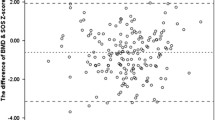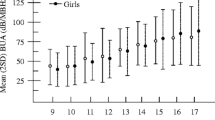Abstract
Summary
Bone density measurements are important for evaluation and follow-up of children with alterations in their mineral status (increased risk for fractures and osteoporosis subsequently). Interpretation of these measurements relies on the availability of appropriate reference equations. We developed gender-specific, age-dependent reference values of bone density for Central European children.
Introduction
In recent years, there has been an increasing demand for the measurement of bone density in children exposed to an increased risk of early alterations in their bone status. These values must be compared to an adequate reference population. The aim of the present study was to create reference equations of radial speed of sound (SOS) for Central European children and adolescents.
Methods
In this cross-sectional study, SOS values were measured at the distal third of the radius in 581 Swiss children and adolescents (321 girls and 260 boys) aged 6 to 16 years using the Sunlight Omnisense® 7000P quantitative ultrasound system.
Results
Gender-specific reference equations for SOS values were derived by polynomial regression and combined a cubic dependence of age and a linear dependence of height. The fitted SOS curves in our study population show a plateau period in both genders for younger ages followed by an increase phase beginning at the age of 12 in girls and 14 in boys. Neither the reported level of physical activity nor additional sport nor self-reported calcium intake influenced the reference equations.
Conclusions
Our results show a good agreement with similar studies using the same measurement technique on other body parts, suggesting a wide applicability of the obtained reference curves over different European populations.


Similar content being viewed by others
Abbreviations
- SOS:
-
Speed of sound
- DXA:
-
Dual-energy X-ray absorptiometry
- QUS:
-
Quantitative ultrasound
- PBM:
-
Peak bone mass
References
Henry Y, Fatayerji D, Eastell R (2004) Attainment of peak bone mass at the lumbar spine, femoral neck and radius in men and women: relative contributions of bone size and volumetric bone mineral density. Osteoporos Int 15:263–273
Pérez-López F, Chedraui P, Cuadros-López J (2010) Bone mass gain during puberty and adolescence: deconstructing gender characteristics. Curr Med Chem 17:453–466
Pitukcheewanont P, Punyasavatsut N, Feuille M (2010) Physical activity and bone health in children and adolescents. Pediatr Endocrinol Rev 7:275–282
Prais D, Diamond G, Kattan A, Salzberg J, Inbar D (2008) The effect of calcium intake and physical activity on bone quantitative ultrasound measurements in children: a pilot study. J Bone Miner Metab 26:248–253
Bonjour J (2005) Dietary protein: an essential nutrient for bone health. J Am Coll Nutr 24:526S–536S
Weldon D (2009) The effects of corticosteroids on bone growth and bone density. Ann Allergy Asthma Immunol 103:3–11, quiz 11–13, 50
Bonjour J, Chevalley T, Rizzoli R, Ferrari S (2007) Gene-environment interactions in the skeletal response to nutrition and exercise during growth. Med Sport Sci 51:64–80
Davies J, Evans B, Gregory J (2005) Bone mass acquisition in healthy children. Arch Dis Child 90:373–378
Cvijetic S, Colic Baric I, Satalic Z (2010) Influence of heredity and environment on peak bone density: a parent-offspring study. J Clin Densitom 13:301–306
Cashman K, Hill T, Cotter A, Boreham C, Dubitzky W, Murray L, Strain J, Flynn A, Robson P, Wallace J, Kiely M (2008) Low vitamin D status adversely affects bone health parameters in adolescents. Am J Clin Nutr 87:1039–1044
Baroncelli G, Saggese G (2005) Effect of GH treatment on bone mass in children with GH deficiency. J Endocrinol Invest 28:23–27
Reix P, Bellon G, Braillon P (2010) Bone mineral and body composition alterations in paediatric cystic fibrosis patients. Pediatr Radiol 40:301–308
Blazina S, Bratanič N, Campa A, Blagus R, Orel R (2010) Bone mineral density and importance of strict gluten-free diet in children and adolescents with celiac disease. Bone 47:598–603
Baroncelli G (2008) Quantitative ultrasound methods to assess bone mineral status in children: technical characteristics, performance, and clinical application. Pediatr Res 63:220–228
van den Bergh J, Noordam C, Ozyilmaz A, Hermus A, Smals A, Otten B (2000) Calcaneal ultrasound imaging in healthy children and adolescents: relation of the ultrasound parameters BUA and SOS to age, body weight, height, foot dimensions and pubertal stage. Osteoporos Int 11:967–976
Sawyer A, Moore S, Fielding K, Nix D, Kiratli J, Bachrach L (2001) Calcaneus ultrasound measurements in a convenience sample of healthy youth. J Clin Densitom 4:111–120
Mughal M, Ward K, Qayyum N, Langton C (1997) Assessment of bone status using the contact ultrasound bone analyser. Arch Dis Child 76:535–536
Wünsche K, Wünsche B, Fähnrich H, Mentzel H, Vogt S, Abendroth K, Kaiser W (2000) Ultrasound bone densitometry of the os calcis in children and adolescents. Calcif Tissue Int 67:349–355
Zhu Z, Liu W, Xu C, Han S, Zu S, Zhu G (2007) Ultrasound bone densitometry of the calcaneus in healthy Chinese children and adolescents. Osteoporos Int 18:533–541
Barkmann R, Rohrschneider W, Vierling M, Tröger J, de Terlizzi F, Cadossi R, Heller M, Glüer C (2002) German pediatric reference data for quantitative transverse transmission ultrasound of finger phalanges. Osteoporos Int 13:55–61
Baroncelli G, Federico G, Vignolo M, Valerio G, del Puente A, Maghnie M, Baserga M, Farello G, Saggese G, Group PQU (2006) Cross-sectional reference data for phalangeal quantitative ultrasound from early childhood to young-adulthood according to gender, age, skeletal growth, and pubertal development. Bone 39:159–173
Halaba Z, Pluskiewicz W (2004) Quantitative ultrasound in the assessment of skeletal status in children and adolescents. Ultrasound Med Biol 30:239–243
Zadik Z, Price D, Diamond G (2003) Pediatric reference curves for multi-site quantitative ultrasound and its modulators. Osteoporos Int 14:857–862
Lequin M, van Rijn R, Robben S, Hop W, van Kuijk C (2000) Normal values for tibial quantitative ultrasonometry in Caucasian children and adolescents (aged 6 to 19 years). Calcif Tissue Int 67:101–105
Christoforidis A, Papadopoulou E, Dimitriadou M, Stilpnopoulou D, Gkogka C, Katzos G, Athanassiou-Metaxa M (2009) Reference values for quantitative ultrasonography (QUS) of radius and tibia in healthy Greek pediatric population: clinical correlations. J Clin Densitom 12:360–368
(1995) Physical status: the use and interpretation of anthropometry. Report of a WHO Expert Committee. World Health Organ Tech Rep Ser 854:1–452
Trimpou P, Bosaeus I, Bengtsson B, Landin-Wilhelmsen K (2010) High correlation between quantitative ultrasound and DXA during 7 years of follow-up. Eur J Radiol 73:360–364
Levine A, Mishna L, Ballin A, Givoni S, Dinari G, Hartman C, Shamir R (2002) Use of quantitative ultrasound to assess osteopenia in children with Crohn disease. J Pediatr Gastroenterol Nutr 35:169–172
Hartman C, Brik R, Tamir A, Merrick J, Shamir R (2004) Bone quantitative ultrasound and nutritional status in severely handicapped institutionalized children and adolescents. Clin Nutr 23:89–98
Acknowledgments
We would like to thank the children and adolescents who participated in the study as well as their parents.
Conflicts of interest
None.
Author information
Authors and Affiliations
Corresponding author
Additional information
Michael J. Scherrer and Mascha K. Rochat contributed equally to this work.
Electronic supplementary material
Below is the link to the electronic supplementary material.
ESM 1
(DOCX 261 kb)
Rights and permissions
About this article
Cite this article
Scherrer, M.J., Rochat, M.K., Inci, D. et al. Reference equations for ultrasound bone densitometry of the radius in Central European children and adolescents. Osteoporos Int 25, 2617–2623 (2014). https://doi.org/10.1007/s00198-014-2807-1
Received:
Accepted:
Published:
Issue Date:
DOI: https://doi.org/10.1007/s00198-014-2807-1




